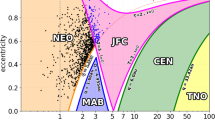Abstract
We consider some aspects of the dynamic evolution of the population of near-Earth asteroids (NEAs): the change of the rate of NEA depletion with time, including the dependence of the rate on the initial parameters of the NEA orbits, the efficiency of various channels of NEA depletion, and diffusion of NEA orbits. We studied both real asteroids and a simulated population. For the study, 3024 real asteroids larger than 1 km with a perihelion distance \(q < 1.6\) A.U. were selected, of which 833 NEAs had \(q < 1.3\), i.e., we explored almost all large NEAs. For some tasks, the population of NEAs was also modeled using NEOPOP (ESA) code. The orbits were integrated for 10 Myr using the REBOUND numerical complex. The solar gravitational field and field of planets, as well as the possibility of collisions, were considered. It is shown that the total population of NEAs has the median time of depletion \({{t}_{{{\text{NEA}}}}} \simeq 3.5\) Myr; this rectifies the estimates of other authors. The main advantage of the present study is that, for the first time, the dependence on the initial values of the orbital parameters—semi-major axis of the orbit and eccentricity was investigated. It is shown that this dependence is very strong: for the subset of asteroids with large \(a\) and \(e\), \({{t}_{{{\text{NEA}}}}}\) it is dozens of times lower than for the subset with small \(a\) and \(e\). Obtained qualitative estimates of the dependence \({{t}_{{{\text{NEA}}}}}(a,\;e)\) are important for the quantitative analysis regarding the various model adequacy of mechanisms of replenishing the population of NEAs. The details of the diffusion (mixing of parameters) of the asteroid orbits in the plane “a–e” in the process of evolution have been studied. During the integration time, 10% of the NEAs were ejected from the Solar System, 1.5% fell onto the planets (including 0.2% onto the Earth), 17% fell onto the Sun, and 12.5% left the NEAs zone.







Similar content being viewed by others
Notes
http://neo.ssa.esa.int/neo-population
https://www.minorplanetcenter.net/data
REFERENCES
B. M. Shustov, Herald Russ. Acad. Sci. 89, 311 (2019).
G. Neukum, B. A. Ivanov, and W. K. Hartmann, in Proceedings of the EGS General Assembly Conference (2002), p. 4075.
S. Mazrouei, R. R. Ghent, W. F. Bottke, A. H. Parker, and T. M. Gernon, Science (Washington, DC, U.S.) 363, 253 (2019).
S. I. Ipatov, E. A. Feoktistova, and V. V. Svettsov, Solar Syst. Res. 54, 384 (2020); arXiv: 2011.00361 [astroph.EP].
W. F. Bottke, D. Vokrouhlický, and D. Nesvorný, Nature (London, U.K.) 449 (7158), 48 (2007).
B. M. Shustov, S. V. Vereshchagin, and M. D. Sizova, INASAN Sci. Rep. 5, 89 (2020).
A. Morbidelli, W. F. Bottke, Jr., C. Froeschlé, and P. Michel, in Origin and Evolution of Near-Earth Objects, Ed. by W. F. Bottke, Jr., A. Cellino, P. Paolicchi, and R. P. Binzel (Univ. Arizona Press, Tucson, 2002), p. 409.
R. G. Strom, M. Renu, Z.-Y. Xiao, T. Ito, F. Yoshida, and L. R. Ostrach, Res. Astron. Astrophys. 15, 407 (2015); arXiv:1407.4521 [astroph.EP].
P. Farinella, C. Froeschlé, R. Gonczi, G. Hahn, A. Morbidelli, and G. B. Valsecchi, Nature (London, U.K.) 371, 314 (1994).
B. Gladman, P. Michel, and C. Froeschlé, Icarus 146, 176 (2000).
D. P. O’Brien and R. Greenberg, in Proceedings of the 34th Annual Lunar and Planetary Science Conference, March 17–21, 2003, League City, TX, Ed. by S. Mackwell and E. Stansbery (2003), abstract No. 2018.
R. V. Zolotarev, B. M. Shustov, and V. I. Korchagin, INASAN Sci. Rep. 5, 225 (2020).
H. Rein and S. F. Liu, Astron. Astrophys. 537, 128 (2012); arXiv: 1110.4876 [astroph.EP].
H. Rein, D. M. Hernandez, D. Tamayo, G. Brown, et al., Mon. Not. R. Astron. Soc. 485, 5490 (2019); arXiv: 1903.04972 [astroph.EP].
H. Rein and D. Tamayo, Mon. Not. R. Astron. Soc. 452, 376 (2015); arXiv: 1506.01084 [astroph.EP].
H. Rein and D. S. Spiegel, Mon. Not. R. Astron. Soc. 446, 1424 (2015); arXiv: 1409.4779 [astroph.EP].
ACKNOWLEDGMENTS
The authors acknowledge V.I. Korchagin for useful advice and discussion of the paper.
Author information
Authors and Affiliations
Corresponding authors
Additional information
Translated by L. Yungelson
Rights and permissions
About this article
Cite this article
Zolotarev, R.V., Shustov, B.M. On the Dynamic Evolution of the Population of Near-Earth Asteroids. Astron. Rep. 65, 518–527 (2021). https://doi.org/10.1134/S1063772921070076
Received:
Revised:
Accepted:
Published:
Issue Date:
DOI: https://doi.org/10.1134/S1063772921070076



